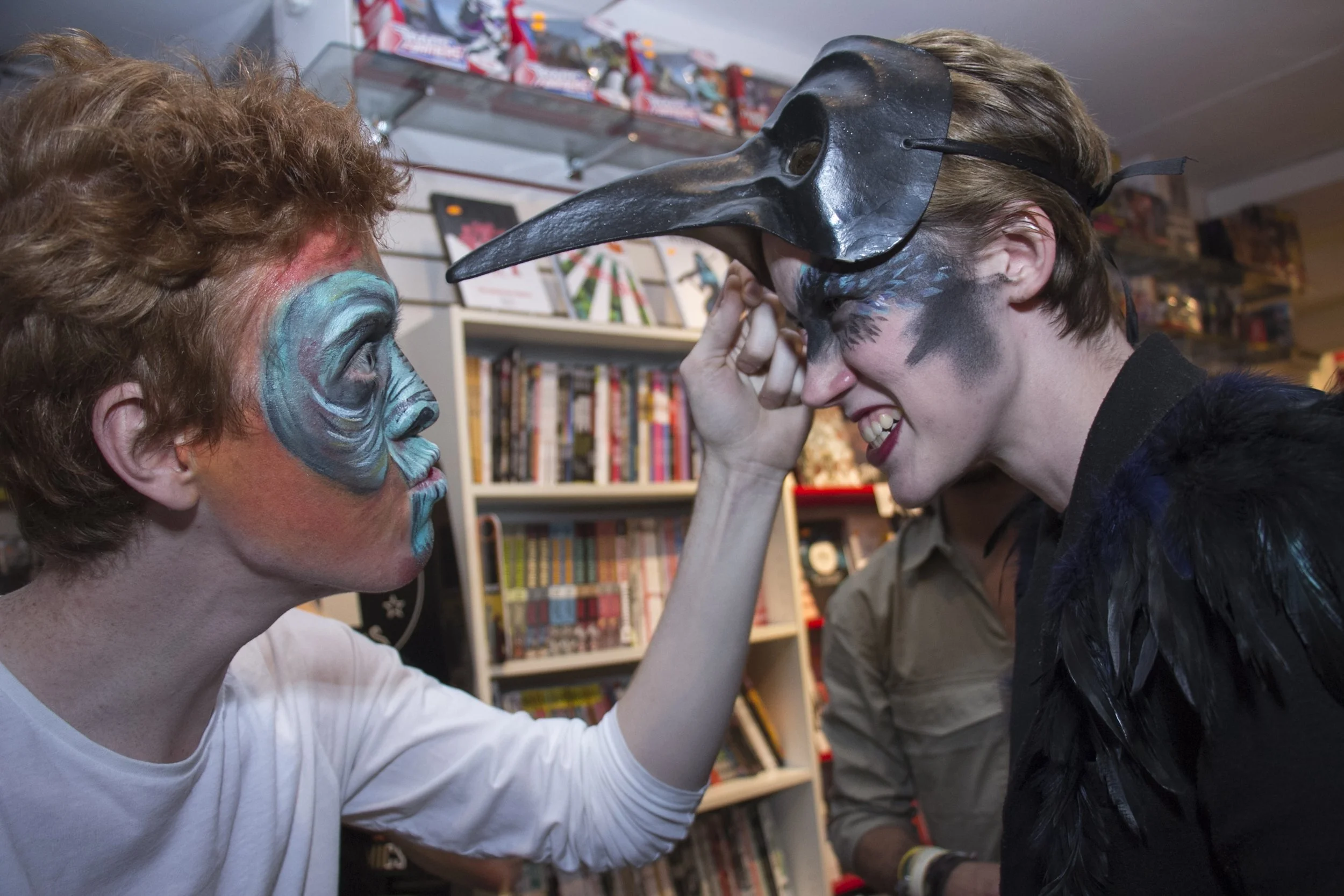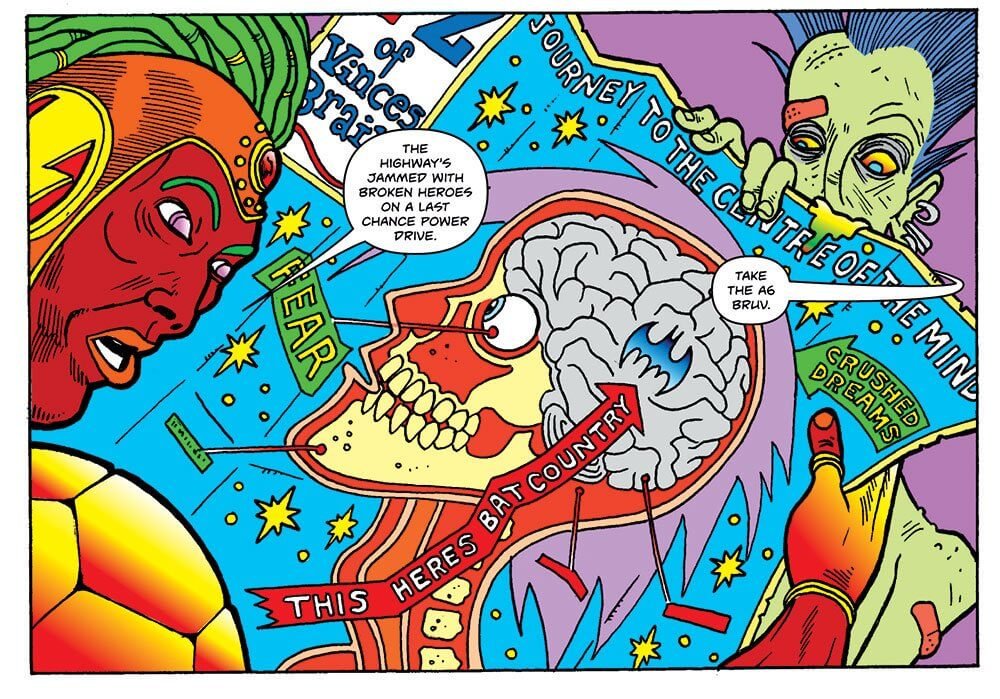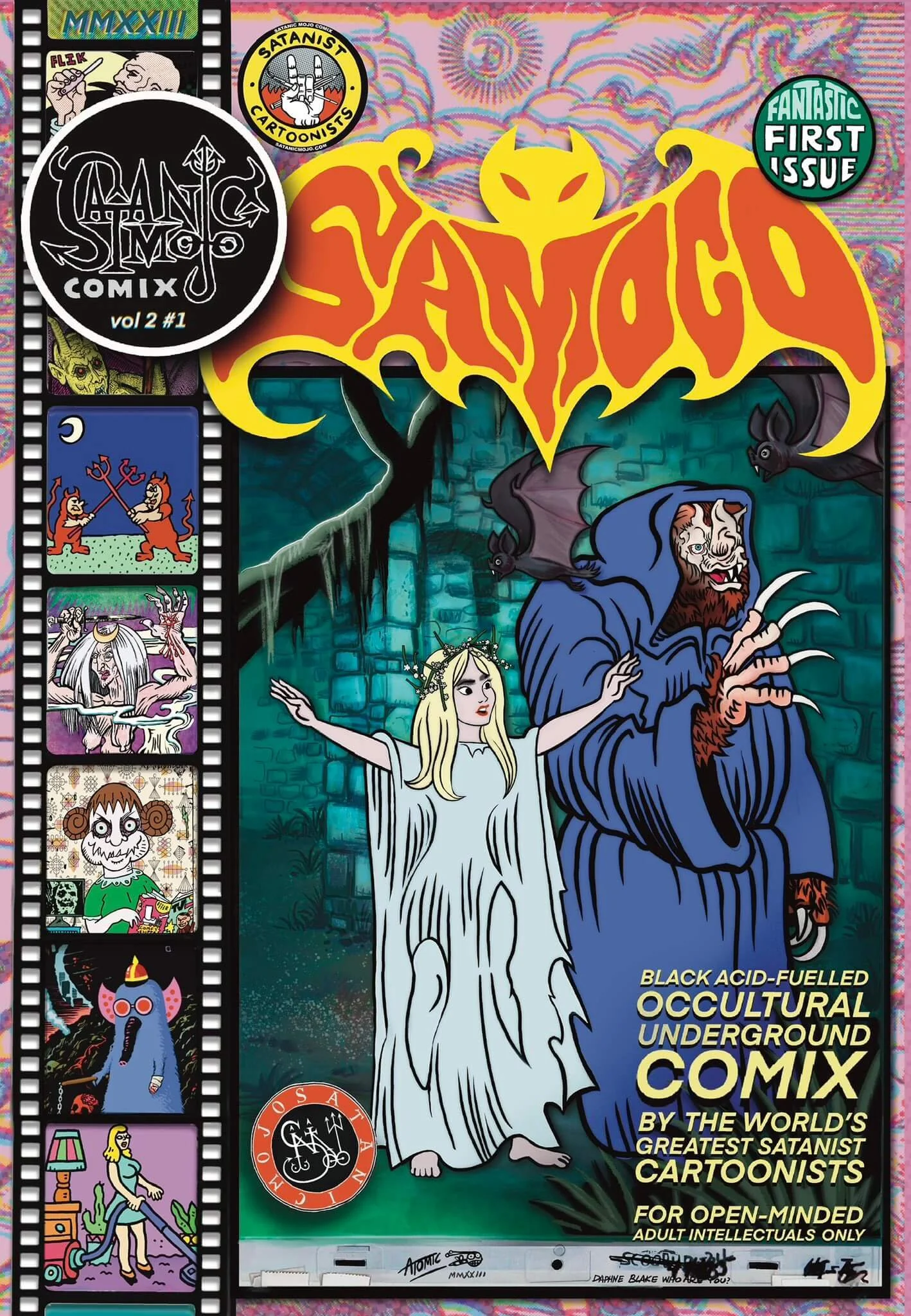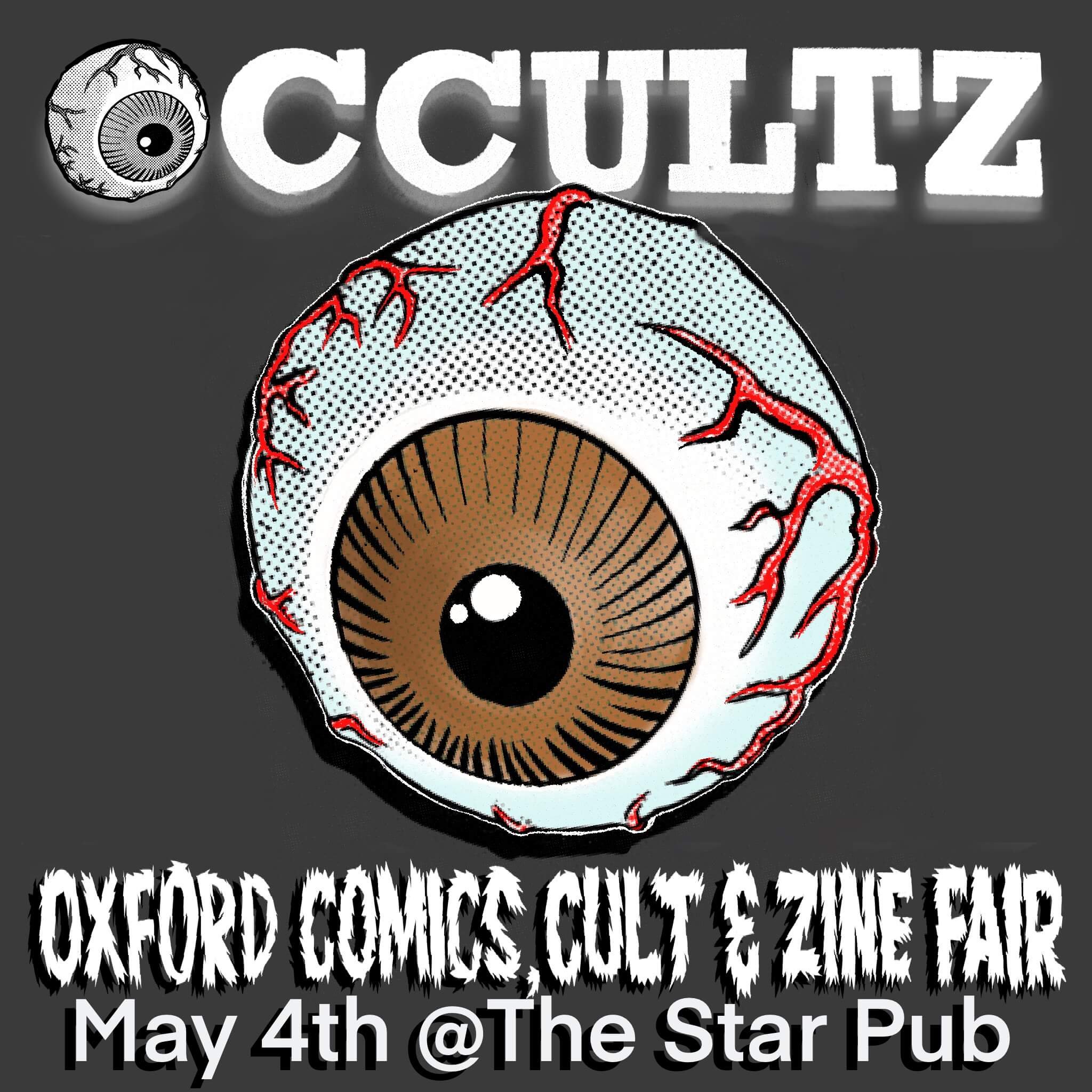The Occultz: Oxford Comic, Cult, and Zine Fair is just a few days away. We thought we’d introduce you to its creators, Owen Michael Johnson and Jason Atomic!
PART ONE, IN WHICH JASON INTERVIEWS OWEN
ATOMIC: By way of an introduction to Occultz, we thought we’d introduce ourselves. We met in the London comic book community that, in pre-pandemic days, centered around Orbital Comics. What brought you there?
JOHNSON: I grew up in Cumbria and had been making comics in a bit of an indie comics community vacuum since I was a teenager (barring a writing degree and a masters). When I moved to London in my mid-20s for a job at Titan Comics, I was thirsty for the kind of clubhouse that Orbital Comics provided. I’d hang out there whenever I wasn’t working, recording podcasts, playing music after hours, meeting other creators and comics people in the city. It was such a formative time for me, so much creative play. I met you Jason, through your events and the manager of the store Karl Asaa. We got on really well and, although we’re very different creators and our work is a world away from each other, I think there’s a shared curiosity and mutual respect of the craft. I moved to Oxford nearly 7 years ago to work at 2000 AD and we stayed in touch until Jason moved out this way in the wake of the Pandemic. It’s been great to reconnect and that’s how OCCULTZ began.
ATOMIC: Performance, costume, and live elements are associated with your comic launches. It seems as if your vision cannot be hemmed in by the page!
JOHNSON: My first experiences making art seriously were in drama classes - I learned creative freedom there. It shaped how I make art and how I present comics, thinking of unique ways to market them that catch your attention. It’s a static medium and feels more urgent if you can make it dynamic. I enjoy art that bleeds across forms and disciplines. When writing the comic that became my calling card, Raygun Roads & The Infinity Loop Death-Trap of Ulysses Pomp, I was on the dole. The idea was to write a cosmic rock star that would pop out of your head when you were hopeless and kidnap you into a pop-art journey to make you want to live again. The artist (who you’ve since worked with on Satanic Mojo) is called INDIO.
ATOMIC: Yes!
JOHNSON: To my mind, they’re one of the finest artists we have in this country, the natural successor to Kevin O’Neill. It just felt natural that the band should exist. So me and dear friends and musicians launched it with a show at Orbital in full cosplay regalia. I jumped out of a cardboard box in lightning bolt leggings. There was a lot of theatre to it. I even got the job at Titan by roping in long-suffering friends to stage a flash mob skit outside the building during my interview. I was still so young, so passionate, and desperate to grab people by the throat, metaphorically.
ATOMIC: And that’s continued for you, right up until now?
JOHNSON: Well, these days I’m working on projects as a writer/artist which asks for something different. Just writing there’s a lot of sitting around waiting for things to get drawn so you can dream up these mad release stunts. There was a ‘70s photoshoot with a bowling alley standing in for Vegas to close out Mirage but it didn’t have an audience. It felt like I needed to send that character off after spending so long with him. It’s hard to explain but all my projects are so personal, sort of having them physically manifest seems so natural.
ATOMIC: What are the differences between illustrating your own story and writing for another artist?
JOHNSON: The sense of pride in finishing a project you’ve written and drawn is immense. It can also be pretty lonely. I love the social aspect of collaborating with others, I seek it out. Even on The Mirage (which you can buy now from The Comic Crush), Colin Bell who lettered it developed it with me and was an ear for so much of my flapping about creatively. Poor guy. It’s special to make something you can’t achieve separately. When I’m drawn to an artist it’s a singular pleasure to write to their strengths and interests.
ATOMIC: Your comics are all very different styles of writing, psychedelic rock opera, Ballardian dystopia, retro thriller, autobiography through a cinematic lens. What draws you to tell such diverse stories?
JOHNSON: I’m evolving as a person all the time, and following my artistic interest wherever it leads. The comics I make just reflect that. I find that really exciting and unpredictable. I don’t know if I can make a romantic comedy, or an existential horror. Let’s give it a go. I certainly know it’s made a jobbing career as an artist less likely but it doesn’t seem true to myself otherwise. Everyone makes art for different reasons, for me since I was young it’s been about processing the world and making a pure expression of my emotions at the time. Everything I do is autobiographical in some way, how that manifests is a journey that I’ll be fascinated with my whole life.
ATOMIC: You’ve been working for some of the UK’s biggest mainstream comic publishers, how does that inform your solo practice?
JOHNSON: I’ve found it’s a gift to learn more about the industry and take power from teaching yourself all the different lessons available. I’ve worked with amazing people, and incredible projects. I got into the industry young and it’s been a learning curve. It’s a business at the end of the day, and starting out I struggled to understand that because I’d only ever made comics for fun. It comes with challenges and perspectives you just don’t see unless you work in it every day. I sell comics and books for my profession and write and draw for my passion. I used to really wrestle with these two elements, but I’ve learned it’s all my career and it’s all teaching me something valuable, and I’m hopefully offering something that is unique to both, as long as I choose to do it.
ATOMIC: It’s a good philosophy to have, especially in the insane world of comics!
PART TWO, IN WHICH OWEN INTERVIEWS JASON
JOHNSON: How did you get into creating art and events in the first place?
ATOMIC: Since I can remember I’ve always drawn, read, and made up my own stories. In the late 80s, while I was squatting in North London, I started to produce my own photocopied comics, they were hand assembled and either sold through mail order via small press directories or at comic shops. In those days we would actually mail each other cheques in the post on the strength of a write-up in a photocopied zine which also published our home addresses!
JOHNSON: You found inspiration elsewhere, outside of North London though, right?
ATOMIC: Yeah. In the 90s I moved to Japan, after a while I gave up on comics and concentrated on journaling, scrapbooking, painting, and drawing from life. In Tokyo, I found, that if you want to host an art exhibition you simply need to rent a gallery space. However, they can be prohibitively expensive. As a result of this, a community of young artists and designers had emerged who would band together to host pop-up events with exhibitions and installations in cafés, shops, and nightclubs which combined art displays with live performances, projections, costumes, DJs, etc. I became an active participant in these scenes and curated some fabulous events.
JOHNSON: And you brought that back to London with you, that sense of participation?
ATOMIC: Definitely. That collaborative and supportive approach stuck with me even when I arrived back in London and it led to a variety of wonderful shows and collaborations. Notably Freaktastic! with Johnny Deluxe, The Art Model Collective with Manko, Iconography of Mask with Garry Vanderhorne at Resistance Gallery, and Hail To The King! (A Jack Kirby tribute show) which started at ‘Resgal’ before moving to Orbital Comics where I went on to curate many shows and events alongside, then manager, the Mighty Karl Asaa whose open-minded, out-of-the-box thinking and supportive approach allowed them to win the UK’s first Eisner Award for comic retail!
JOHNSON: And you took that into comics, not just events, with Satanic Mojo Comix? That’s now a firmly established British underground institution, one that seems to adapt with you as an artist. What is it about this that continues to inspire and challenge you?
ATOMIC: Initially it was a pastiche, a celebration of underground comix and their roots in Golden Age Horror and the weird fiction of the pulps. I was exploring the history of the medium, but although it started as a tribute to late 1960s underground comix, the characters especially Lester Starbeard the gay, hippy witch, drag queen psychonaut came to life for me and demanded to have their tales told. Almost everything they encounter or experience ties back to things from my research in hidden histories and countercultures. witch cults, satanism, lucid dreaming, astral projection, religious cults, rock’n’roll, bike gangs, pulp fiction, weird fiction, the hollow earth… basically it’s my way of processing all the information I’ve absorbed over the years about the occult history of the 20th century.
JOHNSON: You’ve had enormous success with the Satanic Flea Market - what’s the secret to its success? What is it like to expand a community like that?
ATOMIC: The Satanic Flea Market, I like to say, started as a joke the universe took seriously! In 2015 I was gearing up to launch issue 3 of Satanic Mojo comix. The first 2 had been launched at Orbital Comics with much hullabaloo, talks, performances, etc. With number 3 I wanted to do a festival. At the time I was fascinated by the way James Elphick was curating his Guerrilla Zoo events. He incorporated exhibitions with interactive installations and performances. Recognising talent I decided that it would be better to team up than compete. We joined forces for Come to The Sabbat: Festival Of Dark Arts a 2-week extravaganza with talks, screenings, live music, psychedelic walk-in installations, and witchy life drawing.
One of the installations was ‘Kid’s Room’, a call back to the ‘Satanic Panic’, this was basically the contents of my teenage bedroom. As I was assembling it my dad quipped “What are you doing after the show? I don’t want all this crap back in my garage!” and that inspired me to have a sale on the final day and to invite other artists and their pals to join in. So we finished off with a Satanic Flea Market. We were stunned by its popularity and have run them quarterly ever since.
We are very proud of its rapid organic growth, our promotion is predominantly word of mouth and our success relies on good curation of stalls and an authenticity spawned by our refusal to compromise. Since 2015 we’ve seen new fashions and styles emerge and have spawned many imitators it’s a real thrill to be the nucleus of a vigorous and exciting community.
JOHNSON: All your projects seem informed by following your artistic passion and life as a collector with a breadth of interests. How do you think what we read/find and what we make are related?
ATOMIC: We are brought up to think of ourselves as individuals but the fact is that everything is connected and we are just tiny parts of the world and its developing cultures. As a collector I see myself as a commentator and custodian, interpreting and protecting the bits that I see as precious for future generations.
JOHNSON: You are incredibly prolific as an artist - what advice would you give to those who want to start making art?
ATOMIC: Set achievable goals and finish things as you go along. Don’t aim too high. If you want to create a ‘graphic novel’ start with a single page, finish that, and do another.
Don’t waste time aiming for perfection on a single piece, finish it and move on. The great secret is that none of us are ever fully happy with our own work but remember that nobody else knows how it was supposed to look in your head. The crappiest page in the crappiest published comic is worth more culturally than the greatest unfinished piece hidden in your sketchbook.
Talk to other artists you admire, help and support each other. Join group shows, and contribute to zines. Don’t waste time waiting to be discovered, don’t gatekeep, don’t punch down, do as you would be done by, stay true to yourself, be authentic, think global act local, be the change you want to see in the world, Get it out there!
JOHNSON: We should probably close out by talking about why we chose Oxford for our first OCCULTZ event. For me, there’s a happy coincidence that we both live nearby which definitely helps! But more importantly, while Oxford is a world-renowned center of learning and literature, there’s so little representing cult or pop culture art in the city. Also, apart from the great staff and range at Blackwell’s, there are no comic shops! This, along with the big student population, felt like a great environment for us to fill the gap with a different kind of event. Time will tell.
ATOMIC: My partner Manko and I moved to Oxfordshire, from London, during the first lockdown. But I had lived in the area as a teenager. When I first started to seriously collect comics back in the early 80s I would visit Oxford on the bus every weekend to frequent the legendary, and much-missed, Rainbow’s End comic shop at 65 Cowley Road. It was there I’d graduate from my X-Men & Marvel Team-up books to underground comix like Last Gasp’s Slow Death & Skull comix. I was shopping at Rainbow’s End during the time of the ‘British Invasion’ picking up the likes of Camelot 3000 or the Alan Moore Swamp Things, it was there I found classics like Frank Miller’s Daredevil, Simonson’s Thor or the Sienkiewicz illustrated New Mutants. My appreciation of and enthusiasm for comics was really boosted by visiting that shop. Basically, there’s a comics scene-shaped hole in this part of town and I want to help fill it! Owen, what can people expect from the fair?
JOHNSON: We’re aiming for a chilled, inclusive event, small but perfectly formed and built around a passion for all things cult and pop culture. It’s often hard to collect vintage comics in these places, so we’ll have those represented by traders. We’d like to expand to include different branches but this year the organic vibe is about the strong links between grass-roots community, folk art, zines, comics, and most importantly hand-crafted art as an act of resistance. We’re suggesting it for teens and up.
ATOMIC: The Phoenix and the Story Museum does such a wonderful job of representing comics for younger readers, but this is not that. Our exhibitors are reflective of auto-biography, horror, adult, and genre comics, all firmly independently produced. It felt like we could provide something different in Oxford that is open to all, but focused on esoterica, the weirder end of the spectrum. After all, this is the start of Wizard Country…
JOHNSON: Our mission is to establish a local creative hub with OCCULTZ, to nurture a diverse and inclusive community for independent creators and their allies. So expect to encounter a group of enthusiastic artists, craftspeople, and sellers who really care about their craft and media. If you are a like-minded creator, say hello, ask questions, show us your work, and treat it as a tiny convention.
The Occultz: Oxford Comic, Cult, and Zine Fair takes place on 4th May 2024. Its exhibitors include, Karl Asaa, who’ll be trading as Otters Crossing, offering classic comics. For a complete guide to who’ll be exhibiting, follow Jason on Twitter or Owen on Twitter, and follow Occultzine on Instagram. Buy Owen Johnson’s latest comic, The Mirage, here.









